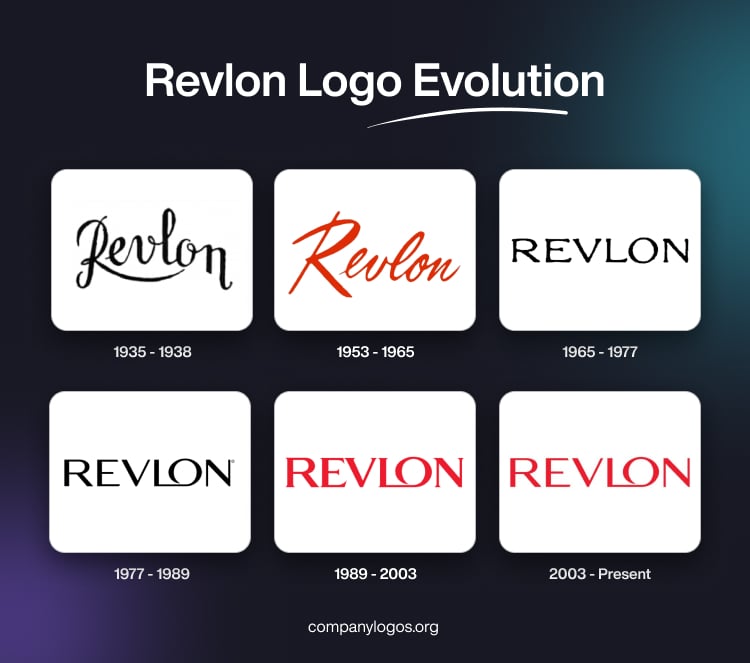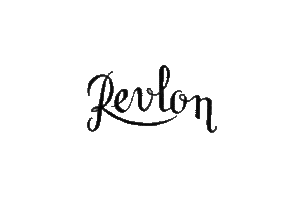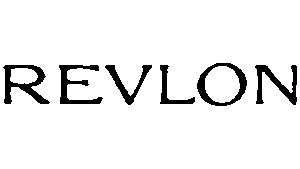
Revlon, Inc. is an American multinational company specialising in cosmetics, skincare, perfume, and personal care products. It is based in New York City and has played a transformative role in the beauty industry for over nine decades. Over the decades, the Revlon logo has undergone various changes, which reflect shifts in design trends and the brand’s evolving identity. However, despite these changes, the logo has consistently embodied the brand’s values of sophistication, creativity, and professionalism. The article delves into the evolution of the Revlon logo and other company details over the years.
The Genesis of the Revlon Logo (1935 – 1938)
In its earliest years, Revlon did not have any official logo, and branding got its focus only around 1935, when the company introduced its first emblem. The initial logo featured the company name in a cursive, script-style font. The design was elegant, with connected lowercase letters and a sweeping uppercase “R” that underlined part of the word. This handwritten logo appeared in black and exuded a sense of luxury and femininity.

(1953 – 1965)
The 1953 logo variant brought a new typeface, which retained the cursive script but with letters that were closer together and slightly sharper. The wordmark leaned to the right to convey motion and energy and was typically displayed in bright red. The colour was used as it was synonymous with Revlon products and the passion of the beauty industry.

(1965 – 1977)
In the 1965 logo iteration, Revlon embraced a more minimalistic design. The script was replaced with bold, uppercase, block sans-serif letters. This new logo had a slightly textured appearance, which highlighted the creative edge of the brand while projecting strength and stability.

(1977 – 1989)
In 1977, Revlon introduced a logo that closely resembles the one recognised today. The uppercase letters in black became sharper and more refined and adopted a serif-style typeface for a sophisticated, professional look. A distinctive feature was the connection between the “L” and “O” at the baseline to symbolise unity and innovation.

(1989 – 2003)
The 1989 logo design was a refinement of the earlier logo, especially in its colour palette, which changed from black to scarlet red. Besides, the contours of the letters were refined, and the serifs were made to look distinct and professional.

(2003 – Present)
The most recent update came in 2003, when Revlon switched to a sleeker, more modern sans-serif typeface while retaining the connected “L” and “O”. This subtle change gave the logo a lighter, edgier, and more forward-thinking aesthetic, which aligned with contemporary design trends.

The Elements of the Revlon Logo
Font
The brand name appears in all uppercase letters, using a clean and modern sans-serif typeface characterised by precise lines and straight-cut letter ends. This custom font closely resembles WT Volkolak Sans Display or Acme Gothic Wide Light, lending the logo a sleek and contemporary feel while maintaining a strong visual identity.
Colour
The current Revlon logo is presented in two bold colour options—red and black—each symbolising passion, style, and professionalism.
The History of Revlon
Revlon was founded on March 1, 1932, during the Great Depression, by brothers Charles and Joseph Revson and chemist Charles Lachman, whose contribution of the “L” helped form the brand’s name. The company began with a single product: a revolutionary nail enamel that used pigments instead of dyes, offering vibrant, opaque colours far superior to the transparent polishes available at the time. This innovation quickly set Revlon apart, and by 1937, its nail polishes were being sold in department stores and pharmacies across the United States.
By 1940, Revlon had expanded its product line to include an entire manicure set and introduced lipstick, further cementing its reputation for quality and innovation. During World War II, Revlon produced makeup for the U.S. Army and was honoured with the Army-Navy “E” Award for Excellence in 1944.
After the war, Revlon emerged as the second-largest cosmetics producer in the U.S. The company diversified its offerings, acquiring a cutlery manufacturer to produce its own manicure tools. Throughout the 1950s, Revlon expanded its product range to include lipsticks, foundations, and other cosmetics, and in 1955, it became a publicly traded company on the New York Stock Exchange.
The 1960s saw Revlon’s international expansion, establishing offices in Europe, Asia, and Latin America and launching innovative products like the first opaque nail enamel and waterproof mascara. The brand became a global beauty leader, known for its bold advertising campaigns and trendsetting products.
Revlon continued to innovate and diversify through strategic acquisitions, such as the purchase of Charles of the Ritz in 1985, which expanded its presence in fragrances and skincare. The company became known for memorable marketing, including the iconic “Fire & Ice” campaign in 1962 and the launch of the Charlie fragrance in 1973.
In 1985, Revlon was acquired by MacAndrews & Forbes, led by Ronald Perelman, and became a private company. The 1990s brought further product innovation with the introduction of ColourStay lipstick and a return to the public market with an initial public offering in 1996.
The 21st century brought new challenges, including increased competition and changing consumer preferences. Despite facing financial difficulties and filing for Chapter 11 bankruptcy in June 2022, Revlon emerged from bankruptcy in May 2023 with a new board and a renewed focus on revitalising the brand.
Today, Revlon products are sold in 150 countries, and the company remains a symbol of empowerment, innovation, and enduring style in the beauty industry. Its legacy is built on a foundation of creativity, bold marketing, and a commitment to helping people express themselves through beauty.
Interesting Facts About Revlon
- Revlon was established in New York City on March 1, 1932, by brothers Charles and Joseph Revson and chemist Charles Lachman. The company began with a modest capital of just $300 at a time when the U.S. economy was struggling.
- The “L” in Revlon comes from Charles Lachman, who joined the Revson brothers as a partner. The name is a blend of “Revson” and “Lachman”.
- The first product of Revlon was a groundbreaking nail enamel that used pigments instead of dyes. It allowed for a wider range of vibrant, opaque colours. This innovation set a new standard in the industry, as most nail polishes at the time were nearly colourless and short-lived.
- Revlon is often credited as the world’s first professional cosmetics brand. It pioneered the concept of selling not just products, but also hope and aspiration through beauty.
- Within six years of its founding, Revlon became a multimillion-dollar company. By 1940, it offered a full manicure line and had expanded into lipsticks.
- During World War II, Revlon produced makeup and other products for the U.S. Army. In recognition of its efforts, the company received the Army-Navy “E” Award for Excellence in 1944.
- Revlon’s first advertisement appeared in The New Yorker magazine in 1935. This marked the beginning of its long history of memorable and trendsetting marketing.
- The 1952 “Fire & Ice” campaign, featuring model Dorian Leigh, is considered one of the most iconic beauty campaigns ever. It helped cement Revlon’s reputation for bold, glamorous marketing.
- Revlon went public in 1955, which allowed it to raise capital for global expansion and further innovation.
- By the 1960s, Revlon had established offices in major cities worldwide, including London, Paris, Hong Kong, and Sydney. Today, its products are sold in 150 countries.
- Revlon introduced several industry firsts, such as the first opaque nail enamel, the first waterproof mascara, and the ColourStay long-wear lipstick in 1994.
- The company expanded its portfolio by acquiring brands like Charles of the Ritz and Elizabeth Arden. It thus broadened its reach in skincare and fragrance.
- In 1989, Revlon became the first cosmetics company to stop testing on animals.
- Revlon has a long history of featuring celebrities in its advertising. These include Dorian Leigh in the 1950s and Halle Berry, Cindy Crawford, and Gal Gadot in more recent decades.
- Despite its iconic status, Revlon faced financial challenges and filed for Chapter 11 bankruptcy in June 2022. It successfully emerged from bankruptcy in May 2023.
Finally
Revlon’s logo evolution is a testament to the brand’s ability to balance tradition with modernity. The core elements of the logo have remained consistent, but subtle refinements have taken place over time. These ensured the brand stays relevant and appealing to new generations of consumers worldwide.